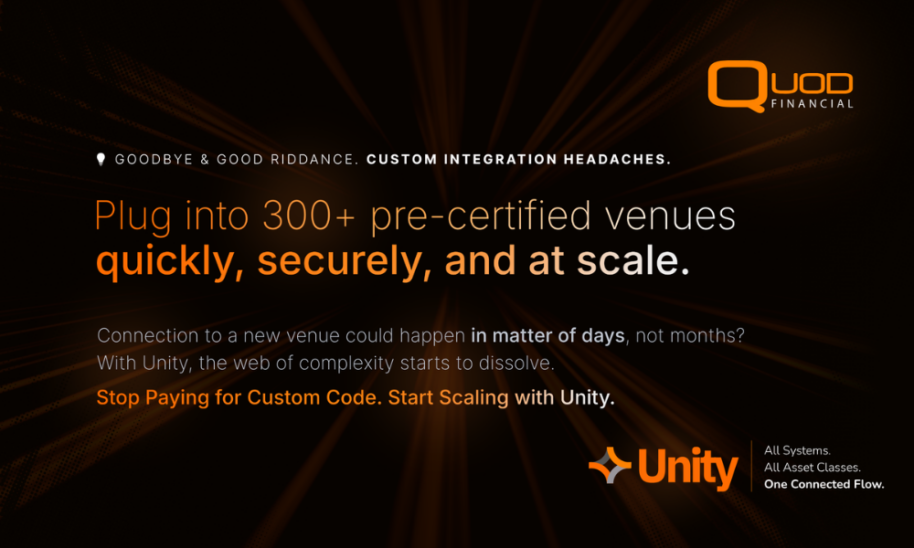
Venues, data vendors, internal systems, liquidity providers, all run on an invisible web of connections. For many, the web has grown organically over time: every new venue means another bespoke integration and another maintenance cycle.
What if connection to a new venue could happen in a matter of days, not months? With Unity, the web of complexity starts to dissolve.
Custom Code and Constant Upkeep
Behind every order routed or trade confirmed lies a chain of messaging links, FIX, APIs, proprietary feeds. Each requires certification, version control, and monitoring.
A typical new connection might look like this:
- A three-month development project to build a custom FIX interface.
- Weeks of certification with the venue.
- Manual testing, deployment, and endless change requests when the protocol updates.
Multiply that by 50 or 100 venues, and what emerges is an ecosystem, costly to manage and nearly impossible to modernize.
“Firms spend millions just keeping the lights on,” notes Medan Gabbay, co-CEO at Quod Financial.
Centralized and Managed Connectivity with Unity
As TNS notes : “When delivered as a fully managed Infrastructure-as-a-Service (IaaS), this can significantly reduce the burden, complexity and cost attributed to firms “going it alone.”
Unity from Quod Financial changes this paradigm. Acting as a centralized integration layer, it connects your trading systems to 300+ ready-to-use endpoints, from exchanges and MTFs to data feeds and internal tools.
Instead of reinventing connectivity for every new venue, firms can:
- Plug into pre-certified connectors managed and maintained by Quod.
- Integrate new venues in hours, not months.
- Offload ongoing updates and maintenance to Quod’s managed service team.
While each firm manages its own commercial relationships, Unity streamlines the technical side, ensuring that every connection is standardized, certified, and continuously maintained.
Managed vs. Manual Connectivity
Here’s how Unity’s managed model compares to the traditional approach:
| Manual Connectivity | Managed Connectivity (Unity) | |
| Integration Time | Months of custom development and testing per venue | Plug-and-play onboarding within hours or days |
| Maintenance | In-house teams manage updates, certifications, and patches | Quod manages all updates and version changes |
| Operational Risk | (High) Every change introduces potential downtime | (Low) Pre-certified connectors minimize breakage |
| Resource Allocation | Engineers focused on low-value maintenance tasks | IT teams freed to innovate and optimize |
| Scalability | Each new connection increases complexity exponentially | Centralized architecture scales effortlessly |
| Cost Impact | Rising IT costs and long delivery cycles | Reduced spend and predictable maintenance costs |
The Payoff: Speed, Savings, and Stability
The payoff of modernizing trading connectivity lies in speed, savings, and stability. Firms no longer need to rebuild systems from scratch to achieve agility.
As The Hive Network observes, “modernising trading infrastructure no longer means ripping everything out and starting again. The emerging approach is architectural, not destructive, building interconnected systems that plug into what’s already there.”
This shift toward modular, vendor-flexible architecture enables faster onboarding, dramatically reducing time-to-market when connecting to new venues, liquidity pools, or data vendors. It also lowers IT spend by freeing engineering teams from the constant upkeep of bespoke integrations, while reducing operational risk through managed updates and standardized interfaces.
With scalable architecture that allows firms to build once and connect anywhere, trading infrastructure evolves from a patchwork of custom links into a unified, resilient layer — one that supports growth without re-engineering at every turn.
—
About Quod Financial
Quod Financial delivers advanced multi-asset trading technology through Unity — a modular, cross-asset architecture designed to interconnect the full order lifecycle. Unity provides normalized integration across all trading workflows, empowering financial institutions to automate, customize, and scale their trading infrastructure without disruption.
Built on Unity, Quod’s product suite includes high-performance OMS, EMS, Smart Order Routing (SOR), Algorithmic Trading, Internalization of Liquidity, and dynamic market connectivity — all accessible through a flexible, data-driven, and AI-enhanced platform.
For more information, visit: www.quodfinancial.com
Quod Marketing | +44 20 7997 7020 | marketing@quodfinancial.com

